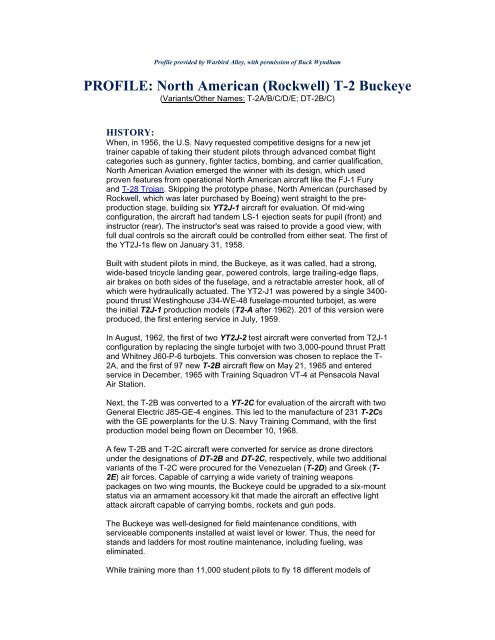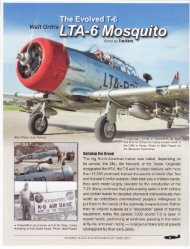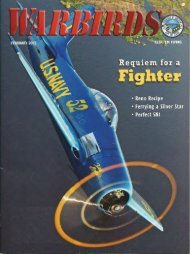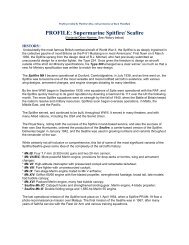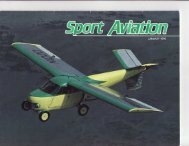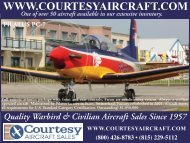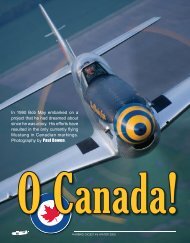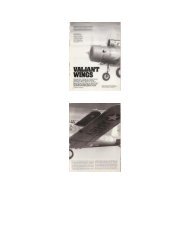PROFILE: North American (Rockwell) T-2 Buckeye - Courtesy Aircraft
PROFILE: North American (Rockwell) T-2 Buckeye - Courtesy Aircraft
PROFILE: North American (Rockwell) T-2 Buckeye - Courtesy Aircraft
- No tags were found...
Create successful ePaper yourself
Turn your PDF publications into a flip-book with our unique Google optimized e-Paper software.
Profile provided by Warbird Alley, with permission of Buck Wyndham<strong>PROFILE</strong>: <strong>North</strong> <strong>American</strong> (<strong>Rockwell</strong>) T-2 <strong>Buckeye</strong>(Variants/Other Names: T-2A/B/C/D/E; DT-2B/C)HISTORY:When, in 1956, the U.S. Navy requested competitive designs for a new jettrainer capable of taking their student pilots through advanced combat flightcategories such as gunnery, fighter tactics, bombing, and carrier qualification,<strong>North</strong> <strong>American</strong> Aviation emerged the winner with its design, which usedproven features from operational <strong>North</strong> <strong>American</strong> aircraft like the FJ-1 Furyand T-28 Trojan. Skipping the prototype phase, <strong>North</strong> <strong>American</strong> (purchased by<strong>Rockwell</strong>, which was later purchased by Boeing) went straight to the preproductionstage, building six YT2J-1 aircraft for evaluation. Of mid-wingconfiguration, the aircraft had tandem LS-1 ejection seats for pupil (front) andinstructor (rear). The instructor's seat was raised to provide a good view, withfull dual controls so the aircraft could be controlled from either seat. The first ofthe YT2J-1s flew on January 31, 1958.Built with student pilots in mind, the <strong>Buckeye</strong>, as it was called, had a strong,wide-based tricycle landing gear, powered controls, large trailing-edge flaps,air brakes on both sides of the fuselage, and a retractable arrester hook, all ofwhich were hydraulically actuated. The YT2-J1 was powered by a single 3400-pound thrust Westinghouse J34-WE-48 fuselage-mounted turbojet, as werethe initial T2J-1 production models (T2-A after 1962). 201 of this version wereproduced, the first entering service in July, 1959.In August, 1962, the first of two YT2J-2 test aircraft were converted from T2J-1configuration by replacing the single turbojet with two 3,000-pound thrust Prattand Whitney J60-P-6 turbojets. This conversion was chosen to replace the T-2A, and the first of 97 new T-2B aircraft flew on May 21, 1965 and enteredservice in December, 1965 with Training Squadron VT-4 at Pensacola NavalAir Station.Next, the T-2B was converted to a YT-2C for evaluation of the aircraft with twoGeneral Electric J85-GE-4 engines. This led to the manufacture of 231 T-2Cswith the GE powerplants for the U.S. Navy Training Command, with the firstproduction model being flown on December 10, 1968.A few T-2B and T-2C aircraft were converted for service as drone directorsunder the designations of DT-2B and DT-2C, respectively, while two additionalvariants of the T-2C were procured for the Venezuelan (T-2D) and Greek (T-2E) air forces. Capable of carrying a wide variety of training weaponspackages on two wing mounts, the <strong>Buckeye</strong> could be upgraded to a six-mountstatus via an armament accessory kit that made the aircraft an effective lightattack aircraft capable of carrying bombs, rockets and gun pods.The <strong>Buckeye</strong> was well-designed for field maintenance conditions, withserviceable components installed at waist level or lower. Thus, the need forstands and ladders for most routine maintenance, including fueling, waseliminated.While training more than 11,000 student pilots to fly 18 different models of
Navy jet aircraft, the <strong>Buckeye</strong> established an outstanding record of safety andreliability for many years, but as the machine has aged it has developed someproblems, being grounded for safety reasons three times in 1997 alone. After41 years of service, the <strong>North</strong> <strong>American</strong> T-2 "<strong>Buckeye</strong>" jet trainer is now beingphased out, in favor of the Boeing/BAE T-45A "Goshawk." At least two T-2shave made their way into civilian ownership. [History by Kevin Murphy]NICKNAMES: Attack Guppy; Trusty TubbyjetSPECIFICATIONS:Engine: One 2,950-lb thrust General Electric J85-GE-4 turbojetWeight: Empty 8,115 lbs., Max Takeoff 13,180 lbs.Wing Span: 38ft. 2in.Length: 38ft. 8in.Height: 14ft. 9.5in.Performance:Maximum Speed: 521 mphCeiling: 44,400 ft.Range: 910 milesArmament: NoneNUMBER BUILT: 529NUMBER STILL AIRWORTHY: At least two are privately-owned andoperated as warbirds; numerous examples still in military service as of 1998.


